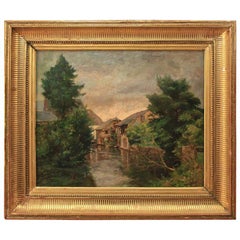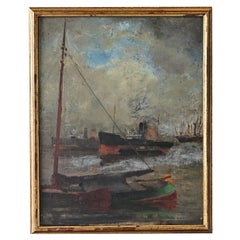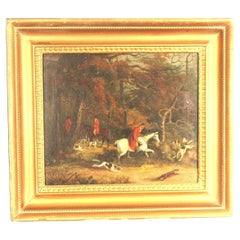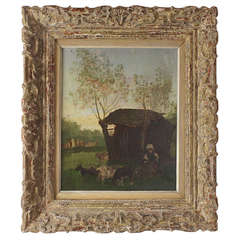Georges Henri Bilhaut Wall Decorations
to
1
1
Height
to
Width
to
1
1
1
1
1
1
1
1
1
1
1
1
436
301
286
282
Creator: Georges Henri Bilhaut
G. H. Bilhaut/France: Painting 'Small Hamlet before a Storm', Early 19th Century
By Georges Henri Bilhaut
Located in Berlin, DE
Georges Henri Bilhaut (1882-1963) /France: Painting 'Small Hamlet before a Storm', Early 19th Century
An evocative scene of a French Val de Lou small villag...
Category
Early 20th Century French Barbizon School Georges Henri Bilhaut Wall Decorations
Materials
Giltwood, Canvas
Related Items
French 19th Century Seascape Painting
Located in Baton Rouge, LA
This petite oil on board depicts a moody scene of sailboats and ships under dynamic cloud cover. Surrounded by a complementary gold gilt frame and fixed with a wire, this interesting...
Category
19th Century French Other Antique Georges Henri Bilhaut Wall Decorations
Materials
Giltwood, Paint
Early 19th century horse painting
By Dean Wolstenholme
Located in Seaford, GB
A Timeless Depiction of the English Fox Hunt
The early 19th-century fox hunting scene, attributed to Dean Wolstenholme Elder, is a stunning representation of the aristocratic traditi...
Category
1810s English Regency Antique Georges Henri Bilhaut Wall Decorations
Materials
Canvas
19th Century French Painting
Located in Atlanta, GA
This striking 19th-century French oil painting on canvas captures an evocative sporting scene featuring three hunting dogs attentively watching a game bird in a lush forest setting. ...
Category
19th Century French Antique Georges Henri Bilhaut Wall Decorations
Materials
Paint, Canvas
French 19th Century Landscape Painting
Located in Los Angeles, CA
Beautiful French 19th Century landscape painting. Old wood original stretchers . Nice old gilt frame too.
Sight dimensions: 15....
Category
19th Century French French Provincial Antique Georges Henri Bilhaut Wall Decorations
Materials
Canvas, Wood
19th Century French Landscape Painting by Gustave Brion
Located in Winter Park, FL
A small 19th century French Impressionist landscape painting by Gustave Brion (1824-1877) a Barbizon School artist from Alsace, depicting the sunrise over a field with haystacks in t...
Category
Late 19th Century Barbizon School Antique Georges Henri Bilhaut Wall Decorations
Materials
Canvas, Giltwood, Paint
Lepoittevin Early 19th Century Marine Oil Painting
By Eugene Le Poittevin
Located in 263-0031, JP
A marine tableau, oil on wood board, by the French Romantic painter Eugène Lepoittevin (1806-1870). The signature “Poitevin” appears in the lower right: our painter seems to have gon...
Category
Mid-19th Century French Antique Georges Henri Bilhaut Wall Decorations
Materials
Canvas
19th Century French Framed Floral Oil Painting
Located in Houston, TX
19th century French framed floral oil painting.
Stunning 19th century French framed oil on canvas painting. This gorgeous well executed Barbi...
Category
1860s French Barbizon School Antique Georges Henri Bilhaut Wall Decorations
Materials
Canvas, Giltwood, Paint
Early 19th Century English Naive Landscape Painting
Located in San Francisco, CA
Early 19th century, English naive landscape painting with bird's-eye maple frame. Cleaned and stretched with good aged surface, circa 1825.
Category
19th Century English Primitive Antique Georges Henri Bilhaut Wall Decorations
Materials
Birdseye Maple, Canvas
18th / Early 19th Century Miniature Painting
Located in Delft, NL
An 18th / early 19th century miniature painting
An 18th / early 19th century miniature painting painted on glass and framed.
The copper framed miniature painting in another copp...
Category
Late 18th Century European Antique Georges Henri Bilhaut Wall Decorations
Materials
Copper
Early 19th century Capriccio Brazil School Painting
Located in Seaford, GB
Rare Early 19th century Capriccio view of Rio de Janeiro Painting
Probably painted circa 1810 by one of Jean-Baptiste Debret, Italian Students.
Painted on Sailcloth.
Historical Context of Early 19th Century Portuguese Colonial Brazil
1.1 Transition from Colony to Empire
During the early 19th century, Brazil underwent a seismic shift in its political status. Originally a colony under the Portuguese Empire, the arrival of the Portuguese Royal Court in Rio de Janeiro in 1808 rapidly elevated the city’s cultural and political importance. By 1815, Brazil was declared a kingdom united with Portugal, setting the stage for the emergence of the Empire of Brazil in 1822. This period of transformation—often termed the transitional period from colony to empire—fueled a wave of artistic production in cities like Rio de Janeiro.
1.2 European Artistic Influence in Brazil
With the French Artistic Mission in Rio (initiated in 1816) and the presence of various Portuguese and European artists, Brazilian art of the early 1800s began to reflect diverse influences, from neoclassical painting to the early rumblings of romanticism. Painters such as Jean-Baptiste Debret, and Nicolas-Antoine Taunay, and local luminaries like Manuel de Araújo Porto-Alegre contributed to the fine arts tradition in Brazil. Their works featured scenes of local life, portraits of Brazilian society, and imaginative vistas—sometimes referred to as “capriccios,” in which real elements were combined with artistic liberties to create an idealized panorama.
1.3 Rio de Janeiro as Cultural and Political Hub
Rio de Janeiro, often called the Imperial capital after Brazil’s independence, was home to foundational institutions like the Imperial Academy of Fine Arts (Academia Imperial de Belas Artes). Later evolving into the Escola de Belas Artes (School of Fine Arts in Rio), these academies nurtured the talents of emerging painters, who found patronage under the Royal Court and, subsequently, the Imperial Court. The city’s significance was further enhanced by the construction of significant buildings, the modernization of infrastructure, and the mingling of European courtly customs with the traditions of local inhabitants.
. Description of the Octagonal Oil on Canvas: A Capriccio View of Rio de Janeiro
2.1 Composition and Layout
The most striking characteristic of this 19th-century Brazilian art piece is its octagonal shape, a relatively unusual format that draws the viewer’s gaze toward its centre. The composition showcases Rio de Janeiro’s shoreline in the early 1800s, brimming with merchant ships and smaller boats anchored near the shore. On the sand, there is a bustling crowd of local people—men and women carrying food and goods on their heads, loading and unloading boats, and engaging in everyday commerce. The backdrop of soaring mountains suggests Rio’s iconic topography, embodying the landscape that famously defines the city.
2.2 Architectural and Religious Landmarks
On the left side, one can discern the silhouette of a church believed to be Santa Lucia, a significant religious structure in the heart of early 19th-century Rio. This element provides viewers with a tangible reference point, linking the scene to an actual location. However, because this painting is labelled as a “capriccio,” the artist might have taken creative liberties by rearranging or amplifying certain features of the city. The melding of real and idealized elements is characteristic of these imaginative vistas.
2.3 Evoking Daily Life in Colonial Rio
One of the painting’s greatest appeals lies in its portrayal of daily life during the colonial era. Men and women from various backgrounds populate the scene. Some appear to be carrying goods on their heads, a common practice in Brazil that has persisted through different centuries. Others appear to be haggling or trading near small vessels, revealing the commercial pulse of an active port city. This focus on local people, combined with the grandeur of merchant ships, captures the tension and synergy between the every day and the extraordinary—a hallmark of Brazilian colonial painting that balances the grand narratives of empire with the rhythms of ordinary life.
2.4 An Amalgamation of Neoclassical and Romantic Influences
Although academic art in early 19th century Brazil was highly influenced by neoclassicism, the onset of romanticism can be spotted in the emotional portrayal of the sky, the lively palette, and the dramatic emphasis on nature’s beauty (the mountains, in particular). This duality reflects the fine arts tradition in Brazil during the transitional phase when artists were embracing multiple styles. As part of the School of Rio or the Rio de Janeiro school, painters often integrated academic techniques learned from European masters with emerging local subjects and influences.
3. Institutions and Artistic Movements
3.1 Imperial Academy of Fine Arts
Originally known as the Royal School of Sciences, Arts, and Crafts, the Imperial Academy of Fine Arts in Rio de Janeiro was instrumental in shaping 19th-century Brazilian art. Influential artists and teachers from Portugal, France, and other European nations congregated at the Academy, imparting their expertise to native students. As the monarchy consolidated power, the Academy enjoyed royal patronage, leading to the creation of Imperial Academy-style works that combined European academic rigour with Brazilian-themed subject matter.
3.2 Impact of the French Artistic Mission
The French Artistic Mission, which arrived in 1816, played a pivotal role in introducing advanced European artistic techniques, thereby elevating the overall quality of painting in Brazil. Artists like Jean-Baptiste Debret not only documented Brazilian society but also spearheaded the development of a local visual identity that aligned with both academicism and the national context of a blossoming empire. Debret, alongside others such as Nicolas-Antoine Taunay, mentored Brazilian artists, sowing the seeds of what would become the Brazilian academic art movement.
3.3 Religious, Historical, and Landscape Paintings
In addition to everyday scenes and historical compositions, religious iconography remained crucial throughout Portuguese colonial and imperial Brazil. Churches were omnipresent in cityscapes like Rio de Janeiro. Many colonial-era Brazilian portraits...
Category
Early 19th Century Brazilian Spanish Colonial Antique Georges Henri Bilhaut Wall Decorations
Materials
Canvas
$2,984 Sale Price
20% Off
H 24.41 in W 26.78 in D 1.97 in
Mid 19th Century French Oil Painting of a Shepherd on Landscape
Located in Scottsdale, AZ
Mid 19th Century French Oil Painting of a Shepherd on a Landscape Background - by Louis Robbe. (1806-1887)
Beautiful painting purchased in France.
Age appropriate wear, see detaile...
Category
19th Century French Barbizon School Antique Georges Henri Bilhaut Wall Decorations
Materials
Wood, Paint
Early 19th Century Oil Painting French Family Portrait
Located in 263-0031, JP
The term “Biedermeier” was first wielded as mildly disparaging designation for the bourgeois domesticity, so idealized by German society in the post-Napoleonic era prior to the 1848 ...
Category
Early 19th Century French Biedermeier Antique Georges Henri Bilhaut Wall Decorations
Materials
Canvas
Previously Available Items
Rural Scene by Georges Henri Bilhaut (1882 -1963)
By Georges Henri Bilhaut
Located in Berlin, DE
Georges Henri Bilhaut is a landscape and still life painter of Abbeville (Somme) in France. The Musée Boucher de Perthes (Abbeville) and the Musée de Picardie (Amiens und Picardie) s...
Category
20th Century French Barbizon School Georges Henri Bilhaut Wall Decorations
Georges Henri Bilhaut wall decorations for sale on 1stDibs.
Georges Henri Bilhaut wall decorations are available for sale on 1stDibs. These distinctive items are frequently made of wood and are designed with extraordinary care. There are many options to choose from in our collection of Georges Henri Bilhaut wall decorations, although brown editions of this piece are particularly popular. Prices for Georges Henri Bilhaut wall decorations can differ depending upon size, time period and other attributes — on 1stDibs, these items begin at $3,400 and can go as high as $3,400, while a piece like these, on average, fetch $3,400.



